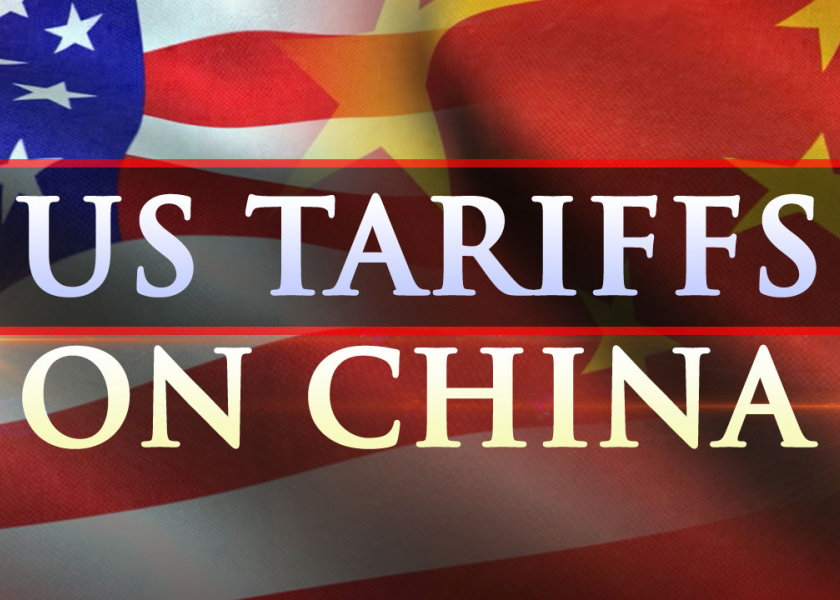China Targets U.S. Farm Imports With Tariffs on Soy, Corn

(Bloomberg) -- Trade tensions between the U.S. and China ratcheted higher after the Asian nation said it will follow through on plans to levy tariffs on a range of American farm goods including soybeans and corn.
An additional 25 percent tariff will levied on about $50 billion of U.S. imports, China’s Ministry of Finance said Saturday in a statement on its website. Tariffs on about $34 billion of those imports will start July 6, covering agricultural products including: soy, corn, wheat, cotton, rice, sorghum, beef, pork, poultry, fish, dairy products, nuts and vegetables.
Farm commodities have been a key battleground in the escalating trade war between the world’s two biggest economies. China previously announced plans to impose 25 percent duties on products including soybeans, wheat, corn, sorghum, cotton and beef in response to proposed tariffs from the U.S. In April, the Asian nation started levying additional taxes on American fruit, nuts, pork and wine.
In 2017, China’s agriculture imports from U.S. were worth $24.1 billion, the People’s Daily reported on May 24, citing customs data. That’s about 19 percent of total farm imports worth $125.86 billion, according to Ministry of Agriculture and Rural Affairs data.
SOYBEANS
China still buys more soybeans from the U.S. than any other agricultural commodity, in a trade that was worth $14 billion last year. It’s the world’s biggest importer and America’s largest buyer. While about a third of U.S. production goes to the Asian country annually, China last year bought more from Brazil. The existing import duty is 3 percent.
China is the world’s biggest pork producer and consumer and its industry relies on soybean meal, a product of soybean crushing, to feed its pigs. Rising costs for hog farmers risk increasing the price of pork, a component of the country’s consumer price index.
CORN
China’s corn imports from the U.S. surged almost 240 percent last year to about 757,000 tons, worth $160 million, according to customs data. That compares with 1.8 million tons imported from Ukraine. Total imports were 2.8 million tons in 2017, well below its 7.2 million ton low-tariff-rate quota. So-called in-quota corn imports incur a 1 percent duty.
The world’s second-biggest corn producer and consumer has been grappling with a glut that’s prompted the government to encourage lower domestic output and increase use of the grain. Chinese buyers can also be wary of U.S. corn as genetically-modified grain sometimes comes under increased scrutiny from authorities.
WHEAT
China is the world’s top wheat consumer and purchases from the U.S. climbed 80 percent last year to 1.6 million tons worth $391 million. That compares with 1.9 million tons imported from Australia. The country hasn’t issued its full low-tariff-rate import quota of 9.6 million tons this year as the world’s largest producer seeks self sufficiency in the staple grain. In-quota wheat imports incur a 1 percent duty.
MEAT
China is one of the world’s fastest-growing beef import markets as western-style steak becomes more popular with middle-class consumers and land constraints limit domestic supply. The Asian country only started buying American beef again last year after banning imports in 2003 when a cow in Washington state was discovered with mad cow disease.
In the six months after the ban was lifted, China purchased $31 million of U.S.-origin beef, U.S. Department of Agriculture data show. The USDA estimates that China’s total imports of beef will top 1 million tons in 2018, compared with 974,000 tons last year.
China has levied an additional 25 percent tariff on pork imports from the U.S. since April. The country currently buys no poultry or poultry products from the U.S. after banning imports because of concerns over bird flu in 2015. In February it dropped anti-dumping and anti-subsidy duties imposed since 2010 on American supplies.
SORGHUM
The grain used in animal feed has been closely watched by agricultural markets as an indicator of the relationship between the two countries. In May, China scrapped an anti-dumping and anti-subsidy probe into imports from the U.S. just a month after imposing a 178.6 percent anti-dumping deposit in an investigation that began in February.
The deposit roiled sorghum trading for a month as buyers scrambled to re-sell more than 20 cargoes of U.S. grain. China imported about $957 million of U.S. sorghum in 2017 and purchases fell 15 percent in the first quarter of this year from a year earlier, according to customs data.
COTTON
Cotton represents another major trade flow from the U.S., the world’s third-biggest producer. Exports of raw cotton from the U.S. fetched $5.8 billion last year, government data show. China levies a 1 percent duty on about 894,000 tons a year of cotton imports that come under its low-tariff-rate quota system. Beyond that, purchases are subject to a duty as high as 40 percent.
Earlier this month, the government issued an additional 800,000 tons of import quotas to private firms to ease concerns about a looming shortage. Purchases from the U.S. were about 506,000 tons in 2017 out of a total 1.2 million tons.
©2018 Bloomberg L.P.







